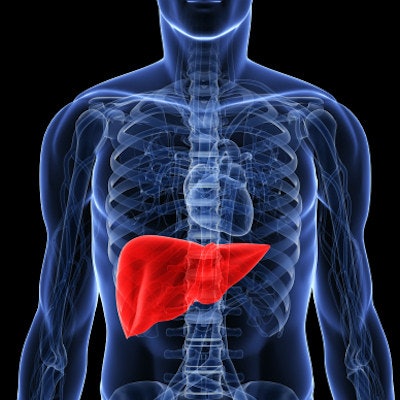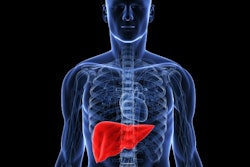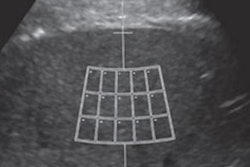
Artificial intelligence (AI) used with contrast-enhanced abdominal CT makes the modality more suited to assess liver steatosis, according to a study published online September 16 in the American Journal of Roentgenology.
The study results suggest a way to identify liver disease in patients who may be undergoing contrast-enhanced CT for other reasons, wrote a team led by Dr. Perry Pickhardt of the University of Wisconsin in Madison. Often, MRI is used to establish proton density fat fractions (PDFF) for assessing liver health, but MRI is a less common exam than CT.
"Because abdominal CT is obtained in clinical practice much more frequently than abdominal MRI, CT can serve as a surrogate for initial detection of steatosis," the group wrote. "Noncontrast CT may represent a practical noninvasive reference standard for routine liver fat quantification."
Recent studies have shown an equivalence between PDFF values and noncontrast CT attenuation, which suggests that CT could be used to quantify liver fat. But although more abdominal CT exams are performed than abdominal MRIs, most are conducted with contrast, which makes evaluating the liver more difficult. Pickhardt and colleagues investigated whether a deep-learning algorithm could boost contrast-enhanced CT's performance for this indication.
The study included 1,204 healthy adults who were potential kidney donors undergoing CT to assess eligibility. Patients underwent both unenhanced and contrast-enhanced CT protocols; the group used PDFF values generated from the unenhanced CT exam data as the reference standard. PDFF thresholds of 5% indicated mild steatosis, while thresholds of 15% or higher indicated moderate.
Unenhanced CT data translated to MR PDFF values found that 50% of the study cohort had mild steatosis and 4.8% had moderate. The deep-learning algorithm was more effective at detecting moderate steatosis, and higher levels of liver attenuation Hounsfield units (HU) tended to produce better performance.
| Performance of deep-learning algorithm plus contrast-enhanced abdominal CT at various levels of liver attenuation | ||||
| PDFF > 5% (mild steatosis) | PDFF > 15% (moderate steatosis) | |||
| Attenuation (HU) | Sensitivity | Specificity | Sensitivity | Specificity |
| 90 | 14.9% | 99.5% | 75.9% | 95.7% |
| 95 | 22.7% | 98.3% | 87.9% | 91.6% |
| 100 | 34% | 94.2% | 96.6% | 83.9% |
| 105 | 42% | 87.4% | 96.6% | 76.2% |
| 110 | 50.9% | 75.7% | 98.3% | 65.5% |
The deep-learning algorithm made contrast-enhanced CT feasible for assessing liver fat content, at least for moderate steatosis, although the group did acknowledge that the modality's performance was less effective when it came to distinguishing between normal livers and those with mild disease.
Yet despite this limitation, the results show promise regarding the combination of AI and contrast-enhanced CT, according to the investigators.
"Large volumes of abdominal CT are performed each year, presenting an opportunity to screen for many conditions beyond the primary imaging indication," they concluded. "Many of these opportunistic tasks can be automated through AI, avoiding subjectivity and time constraints related to manual measurements."





















